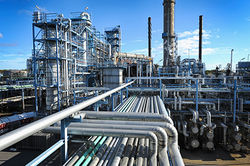Documentation:CHBE Exam Wiki/Module 2 - Reactors
| CHBE 241 Exam resources wiki | |
|---|---|

| |
| Chemical and Biological Engineering | |
|
Welcome to the CHBE Exam Resources Wiki!
This wiki is intended to host past exams | |
| Past Exams | |
| Final Exam 2016W | |
| Midterm Exam 1 2016W | |
| Midterm Exam 2 2016W | |
| Problem Sets | |
| Module 1 - Process Basics | |
| Module 2 - Reactors | |
| Module 3 - Separations 1 | |
| Module 4 - Separations 2 | |
| Module 5 - Non-reactive Energy Balances | |
| Module 6 - Reactive Energy Balances | |
Question 1
A stack gas contains mol percentages of 60% N2, 20% CO2, 10% O2 and the rest is water. What is the composition of CO2 on a dry basis?
Using a basis of 100 moles, the total number of moles of all the species present excluding water is
Hence, the total composition of CO2 on a dry basis is,
Question 2
Reindeers are a source of great contention in Jasper. Therefore it has been decided that their population should decrease by 100 reindeers/yr. If 500 reindeers are born each year, and wolves/bears eat 300 reindeers/yr, how many reindeers have to be relocated from Jasper to meet the goal?
Mass balance:
Question 3
The waste stream for a natural gas processing facility is treated to remove the sulfur dioxide where the initial concentration of SO2 is 5 mol% and the remainder is air. In a scrubber, the waste gas is mixed with pure water flowing at 100 L/min. The only mass transfer that occurs in this process is the transfer of some SO2 into the water. It was found that the concentration of SO2 in the waste gas vented and exiting water stream are 0.5 wt% and 40 wt% respectively.
Question 3a
Draw a block flow diagram for the described process.
Question 3b
Calculate the molar flow rates of all the streams
Step 1 - Determine the molar flow rate for Stream 3
Step 2 - Determine the average molecular weight for Stream 4
Step 3 - Determine the molar flow rate for Stream 4
Using the water balance,
Step 4 - Determine the flow rates of Stream 1 and Stream 2
Overall balance,
Air balance,
The flow rate of the streams are,
Question 4
The following equation shows the combustion process of ammonia to produce nitric oxide:
4NH3 + 5O2 → 4NO + 6H2O
Question 4a
Calculate the ratio of O2 reacted to NO formed on a lb-mol basis
Question 4b
If ammonia is fed to a continuous reactor at a rate of 100.0 kmol/h, what oxygen feed rate would correspond to 50.0% excess O2 ?
The theoretical amount of O2 reacted is
The amount of O2 fed is
Question 4c
If 120 kg of oxygen and 60 kg of ammonia are fed into a batch reactor, determine
- the limiting reactant
- the percentage at which the other reactant is in excess
- extent of reaction
- mass of NO produced
Limiting reactant:
Hence, oxygen is the limiting reactant
Required NH3
Excess NH3
Extent of reaction:
Mass of NO:
Question 5
The production of monochloroethane (C2H5Cl) follows the following process in a reactor.
where dichloroethane (C2H4Cl2) is the undesired product. The selectivity of the desired to the undesired product is 3:1.
The fresh feed to the process contains chlorine (Cl2) and ethane (C2H6) at 200 mol/hr and 100 mol/hr, respectively. The outlet of the reactor is then fed into a separator where all of the desired product, C2H5Cl is separated in the bottoms. The single-pass conversion is not 100%. Therefore, most of the top stream of the separator is recycled back and mixed with the fresh feed before being they are fed to the reactor. A small fraction of the top stream of the separator is purged.
Question 5a
Draw a block flow diagram showing the important unit operations and streams in the process described above.
Question 5b
Perform a degree of freedom analysis for the overall process and show whether the system is fully specified.
| Parameter | Values |
|---|---|
| Unknowns | 5 (n4, n6,HCl, n6,Cl2, n6,C2H4Cl2,n6,C2H6) |
| atomic balances | 3 (C, H, Cl) |
| Other relationships | 1 (Selectivity) |
| DOF | 1 |




















